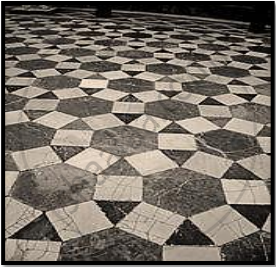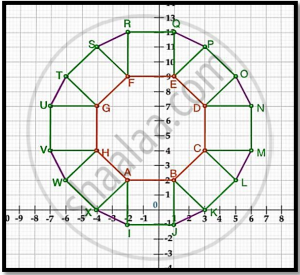Advertisements
Advertisements
Question
Find the area of quadrilateral PQRS whose vertices are P(-5, -3), Q(-4,-6),R(2, -3) and S(1,2).
Solution
By joining P and R, we get two triangles PQR and PRS.
`"let" P (x_1, y_1) = P (-5,-3) , Q(x_2,y_2) = Q(-4,-6), R (x_3,y_3) = R(2,-3) and . Then S(x_4,y_4) = S(1,2)`
`"Area of " ΔPQR = 1/2 [ x_1 (y_2-y_3) +x_2(y_3-y_1)+x_3 (y_1-y_2)]`
`=1/2 [-5(-6+3)-4(-3+3)+2(-3+6)}`
`=1/2 [15-0+6]=21/2 sq. units`
`"Area of "Δ PRS = 1/2 [ x_1(y_3-y_4) +x_3 (y_4-y_1)+x_4(y_1-y_3)]`
`=1/2[-5(-3-2)+2(2+3)+1(-3+3)]`
`=1/2[25+10+0]=35/2 sq. units`
So, the area of the quadrilateral PQRS is `21/2+35/2=28 ` sq. units
APPEARS IN
RELATED QUESTIONS
If two opposite vertices of a square are (5, 4) and (1, −6), find the coordinates of its remaining two vertices.
Show that the points (−3, 2), (−5,−5), (2, −3) and (4, 4) are the vertices of a rhombus. Find the area of this rhombus.
Name the quadrilateral formed, if any, by the following points, and given reasons for your answers:
A(-3, 5) B(3, 1), C (0, 3), D(-1, -4)
Find a point on y-axis which is equidistant from the points (5, -2) and (-3, 2).
Show that the following points are the vertices of a square:
(i) A (3,2), B(0,5), C(-3,2) and D(0,-1)
The line segment joining the points A(3,−4) and B(1,2) is trisected at the points P(p,−2) and Q `(5/3,q)`. Find the values of p and q.
If the point A(0,2) is equidistant from the points B(3,p) and C(p, 5), find p.
Find the point on x-axis which is equidistant from points A(-1,0) and B(5,0)
ΔXYZ ∼ ΔPYR; In ΔXYZ, ∠Y = 60o, XY = 4.5 cm, YZ = 5.1 cm and XYPY =` 4/7` Construct ΔXYZ and ΔPYR.
Find the value of k, if the points A(7, −2), B (5, 1) and C (3, 2k) are collinear.
Find the value of k, if the points A (8, 1) B(3, −4) and C(2, k) are collinear.
what is the value of \[\frac{a^2}{bc} + \frac{b^2}{ca} + \frac{c^2}{ab}\] .
If points Q and reflections of point P (−3, 4) in X and Y axes respectively, what is QR?
Any point on the line y = x is of the form ______.
Write the equations of the x-axis and y-axis.
If the sum of X-coordinates of the vertices of a triangle is 12 and the sum of Y-coordinates is 9, then the coordinates of centroid are ______
Write the X-coordinate and Y-coordinate of point P(– 5, 4)
(–1, 7) is a point in the II quadrant.
A tiling or tessellation of a flat surface is the covering of a plane using one or more geometric shapes, called tiles, with no overlaps and no gaps. Historically, tessellations were used in ancient Rome and in Islamic art. You may find tessellation patterns on floors, walls, paintings etc. Shown below is a tiled floor in the archaeological Museum of Seville, made using squares, triangles and hexagons.

A craftsman thought of making a floor pattern after being inspired by the above design. To ensure accuracy in his work, he made the pattern on the Cartesian plane. He used regular octagons, squares and triangles for his floor tessellation pattern

Use the above figure to answer the questions that follow:
- What is the length of the line segment joining points B and F?
- The centre ‘Z’ of the figure will be the point of intersection of the diagonals of quadrilateral WXOP. Then what are the coordinates of Z?
- What are the coordinates of the point on y-axis equidistant from A and G?
OR
What is the area of Trapezium AFGH?
